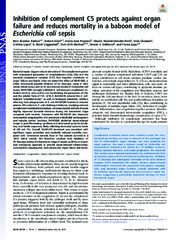Inhibition of complement C5 protects against organ failure and reduces mortality in a baboon model of Escherichia coli sepsis
Permanent lenke
https://hdl.handle.net/10037/13062Dato
2017-07-18Type
Journal articleTidsskriftartikkel
Peer reviewed
Forfatter
Keshari, Ravi Shankar; Silasi, Robert; Popescu, Narcis Ioan; Patel, Maulin Mukeshchandra; Chaaban, Hala; Lupu, Cristina; Coggeshall, K. Mark; Mollnes, Tom Eirik; DeMarco, Steven J.; Lupu, FloreaSammendrag
Bacterial sepsis triggers robust activation of the complement system with subsequent generation of anaphylatoxins (C3a, C5a) and the terminal complement complex (TCC) that together contribute to organ failure and death. Here we tested the effect of RA101295, a 2-kDa macrocyclic peptide inhibitor of C5 cleavage, using in vitro whole-blood assays and an in vivo baboon model of Escherichia coli sepsis. RA101295 strongly inhibited E. coli-induced complement activation both in vitro and in vivo by blocking the generation of C5a and the soluble form of TCC, sC5b-9. RA101295 reduced the E. coli-induced “oxidative burst,” as well as leukocyte activation, without affecting host phagocytosis of E. coli. RA101295 treatment reduced plasma LPS content in E. coli-challenged baboons, implying reduced complement-mediated bacteriolysis, whereas treated animals showed slightly improved bacterial clearance during the bacteremic stage compared with controls. Treatment with RA101295 also improved consumptive coagulopathy and preserved endothelial anticoagulant and vascular barrier functions. RA101295 abolished sepsis-induced surges in proinflammatory cytokines and attenuated systemic circulatory and febrile responses, likely reflecting decreased systemic levels of LPS and C5a. Overall, RA101295 treatment was associated with significant organ protection and markedly reduced mortality compared with nontreated controls (four of five animals survived in a 100% lethal model). We therefore conclude that inhibition of C5 cleavage during the bacteremic stage of sepsis could be an important therapeutic approach to prevent sepsis-induced inflammation, consumptive coagulopathy, and subsequent organ failure and death.
Beskrivelse
Source at https://doi.org/10.1073/pnas.1706818114.


 English
English norsk
norsk